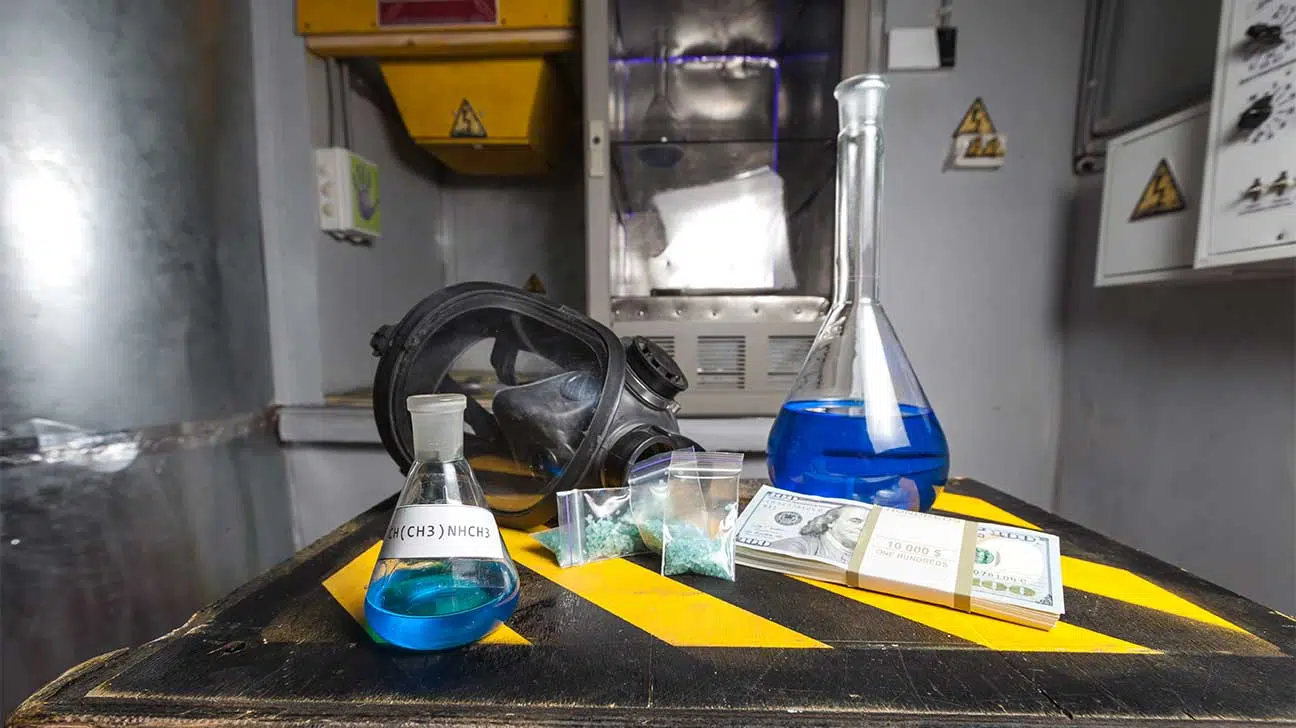How Is Meth Made? Ingredients And Cutting Process
Meth labs use complicated processes to turn common over-the-counter medicines into methamphetamine. These processes are dangerous, involving harsh chemicals and the possibility of explosions.

Methamphetamine is an addictive drug that speeds up the central nervous system. It is often snorted or injected.
One form of meth, called crystal meth, is a smokable version of the drug that can be heated in a glass pipe or bong.
Meth produces a powerful, energetic high within minutes of use. However, it also produces several negative health effects, including meth addiction.
Some of the negative effects of meth come from the cooking process. Meth contains several harmful ingredients, most of which are not meant for human consumption.
What Are The Ingredients In Meth?
Because meth is an illicit substance, people who buy meth have no way of knowing what ingredients have been included in their drugs.
Meth uses several common ingredients, but those ingredients may have different amounts from one batch to the next.
Furthermore, some batches of meth may contain additives that others do not contain.
Law enforcement agencies have found varying additives in different batches.
Primary Meth Ingredients
The primary ingredients in meth are usually ephedrine and pseudoephedrine, two decongestants often found in cold medicines. The first step in meth production is often obtaining these drugs.
In the United States, cold medicines with these two ingredients were easily obtained over the counter for many years.
However, to mitigate rising substance abuse numbers, many states now enforce stricter regulations on these drugs.
Although they are still available, in several states, they are only available from behind a pharmacy counter, and there are limits to how much a person can buy.
Some people avoid these regulations by buying medicine from multiple locations, obtaining fake identification or importing meth from Mexico.
Meth Chemical Additives
After a meth cook obtains their primary ingredients, they mix those ingredients with toxic chemicals that can often be found in common household items.
Some of the most common chemicals in meth include:
- acetone (found in nail polish remover and paint thinner)
- anhydrous ammonia (found in fertilizer)
- hydrochloric acid (a substance used to manufacture plastic)
- lithium (a type of metal often found in batteries)
- methanol (found in antifreeze)
- red phosphorus (found in explosives)
- toluene (a solvent found in certain fuels, paints, paint thinners, and degreasers)
- sodium hydroxide or lye (used in some foods, soaps, and household ingredients)
- sulfuric acid (an ingredient in drain cleaner)
Meth Cutting Agents
Sometimes, meth is cut with other white powder substances to increase the volume of the product.
Although these cutting agents, which can include baking soda and milk powder, are benign when used correctly, they are not intended to be smoked, snorted, or injected.
Using these ingredients incorrectly may cause physical health problems.
Is There Fentanyl In Meth?
Some batches of meth contain fentanyl, a powerful and highly dangerous opioid. Fentanyl is more potent than other opioid drugs.
As a result, it can cause a potentially fatal overdose, even in small amounts.
Fentanyl is often mixed into other drugs, including meth, to increase their volume and potency.
As a result, many people have consumed fentanyl unintentionally and have experienced devastating health consequences.
Some harm reduction organizations now offer fentanyl test strips, which detect the presence of fentanyl in cocaine, heroin, and other drugs.
The Meth Manufacturing Process
The meth manufacturing process is both risky and complex. The process often causes fires and explosions. Cooking meth also creates large amounts of toxic waste.
Meth labs are usually found in homes, trailers, motel rooms, and other relatively small spaces. Containers, hoses, jars, and filters can all be signs of a meth lab.
Traditional Meth Manufacturing
Generally, people make meth by combining either ephedrine or pseudoephedrine with a solvent derived from a household chemical. Then, they heat the mixture until it becomes crystallized.
The “Shake And Bake” Meth Process
To make meth, a person needs to obtain their ingredients in large amounts. Cooking even a pound of meth can become especially difficult, requiring many boxes of cold medicine.
However, because of increased regulations, it is more difficult to gather these ingredients today than in the past.
Smaller amounts of meth can be made using the “shake and bake” method.
During this process, cold medicine pills are placed into a bottle containing chemical additives. The mixture is then sealed and shaken.
This process is even more dangerous than the traditional method of making meth, and it often fails. If the bottle is not tightly sealed, the mixture carries a high risk of explosion.
Find Help For Methamphetamine Use
Meth addiction is a difficult and dangerous disorder that impacts both physical and mental health.
However, it is a treatable condition, and the right addiction treatment can help people recover from meth use and regain control over their health.
Spring Hill Recovery Center offers several levels of care for meth addiction, including meth detox, outpatient drug treatment, and inpatient rehab in Massachusetts.
If you or a loved one need help to recover from stimulant drug abuse, contact our treatment center today for more information about your behavioral health recovery options.
- European Monitoring Centre For Drugs And Drug Addiction —- Methamphetamine Drug Profile https://www.emcdda.europa.eu/publications/drug-profiles/methamphetamine_en
- National Institute On Drug Abuse — How Is Methamphetamine Manufactured? https://nida.nih.gov/publications/research-reports/methamphetamine/how-methamphetamine-manufactured
- North Carolina State Bureau Of Investigations — Signs Of A Meth Lab https://www.ncsbi.gov/Divisions/Special-Services-Unit/Clandestine-Labs/Signs-of-A-Meth-Lab


